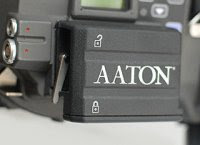The first image in “Film Socialism,” Jean-Luc Godard's latest, is of two red-headed parrots, side by side on a tree limb. The parrots are among a handful of animals that appear in the movie, including a pair of hilariously talkative cats (whose meows are, in turn, parroted by a young woman watching them on a laptop), as well as a llama and a donkey.
Surrounding these animals is a menagerie of talking, quoting, babbling human beings, speaking in French, German, Russian, English and Arabic, among other tongues.
______________________________________________
"Genesis of a Camera: Jean-Pierre Beauviala and Jean-Luc Godard
Camera Obscura Vol. 5, No. 13/14 (Spring-Summer 1985): 163-193.
We are reprinting this discussion between Jean-Pierre Beauviala and
Jean-Luc Godard because it represents one of the most unusual exchanges on the relationship between aesthetics and technology that we have seen. It is highly unlikely that an interview witht his kind of emotional tenor would ever find its way into a journal like AMERICAN
CINEMATOGRAPHER, for example, even though it is concerned throughout with the development of a new 35mm camera and its potential uses. Jeane-Pierre Beauviala is responsible for a series of inventions that resulted in the Aaton 16mm camera, nicknamed “the cat” because of the way it is designed to balance on the shoulder (hence the references to the camera as an animal); the perfection of super-16 (made to be blown up to 35mm without image distortion); and the PALUCHE, which is referred to frequently in the discussion below. The PALUCHE is a small video camera that is held in the hand like a microphone or a flashlight. Because of its size and mobility, the PALUCHE becomes an extension of the hand rather than the eye.
Jean-Luc Godard because it represents one of the most unusual exchanges on the relationship between aesthetics and technology that we have seen. It is highly unlikely that an interview witht his kind of emotional tenor would ever find its way into a journal like AMERICAN
CINEMATOGRAPHER, for example, even though it is concerned throughout with the development of a new 35mm camera and its potential uses. Jeane-Pierre Beauviala is responsible for a series of inventions that resulted in the Aaton 16mm camera, nicknamed “the cat” because of the way it is designed to balance on the shoulder (hence the references to the camera as an animal); the perfection of super-16 (made to be blown up to 35mm without image distortion); and the PALUCHE, which is referred to frequently in the discussion below. The PALUCHE is a small video camera that is held in the hand like a microphone or a flashlight. Because of its size and mobility, the PALUCHE becomes an extension of the hand rather than the eye.
In Grenoble, where Aaton is located, Beauviala worked with Godard for
several years on the development of specialized video and film
equipment, while Godard was living just across the French border in
Rolle, Switzerland. They intended to create a new 35mm camera that would
have the technical simplicity and flexibility of super-8, so that a
non-specialist, a director like Godard, could use it for spontaneous,
brief shots that could be intercut with 35mm work done by professional
cinematographers. A camera called the Aaton 35-8 was subsequently
marketed, but not exactly in the form originally envisioned by either of
them. Just how the technology would develop-according to whose
needs-took on an increasingly personal dimension as time went on,
culminating in a major dispute between filmmaker and inventor. At the
meeting chronicled below, Godard and Beauviala voice their complaints in
language that mixes metaphors about art, love and technology. It quickly
becomes evident that their friendship is being contested as much as the
merits of one camera design over another."
several years on the development of specialized video and film
equipment, while Godard was living just across the French border in
Rolle, Switzerland. They intended to create a new 35mm camera that would
have the technical simplicity and flexibility of super-8, so that a
non-specialist, a director like Godard, could use it for spontaneous,
brief shots that could be intercut with 35mm work done by professional
cinematographers. A camera called the Aaton 35-8 was subsequently
marketed, but not exactly in the form originally envisioned by either of
them. Just how the technology would develop-according to whose
needs-took on an increasingly personal dimension as time went on,
culminating in a major dispute between filmmaker and inventor. At the
meeting chronicled below, Godard and Beauviala voice their complaints in
language that mixes metaphors about art, love and technology. It quickly
becomes evident that their friendship is being contested as much as the
merits of one camera design over another."
Courtesy of Cinema=Godard=Cinema



No comments:
Post a Comment